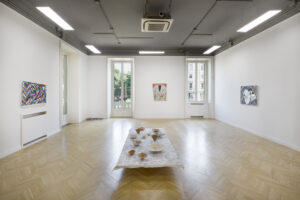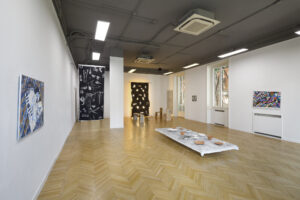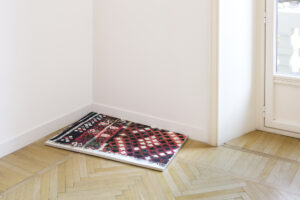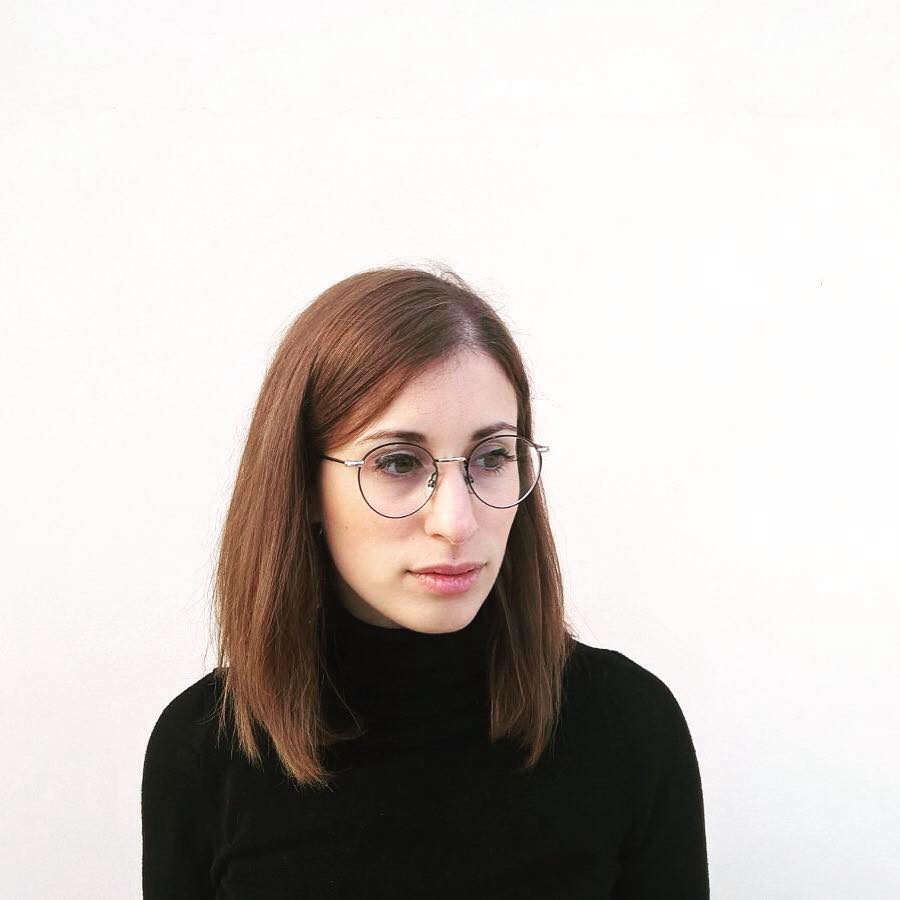While reading some texts in order to write on Andrea Grotto’s solo exhibition at Nashira Gallery, Milan, I encountered this sentence: «Living is like coming into the world». There is much of Grotto’s work in this statement, especially focusing on his new series of works that are about a house inhabited by relationships. Here the house is not understood only as a space but also as a story. Although this is not an interactive exhibition, the exhibited pieces give the viewer the sensation to having touched them before: the pullover looks like it has been worn by your mother and concerning the kilim carpet it looks like it has been given to you by a Venetian friend and to have step on it a thousand times. Isn’t this the feeling for which being truly at home?

Andrea Grotto, Casabase, exhibition view, Nashira Gallery, Milan, 2023. Courtesy the artist and Nashira Gallery
Grotto presents a layered and multimedia project: each work harks back to a past history taken up in the present within a new dimension/space. The wood of the seats and the doilies of grandparents’ homes, for example, take back to personal stories that we have the perception of having already lived through. My first thought was about to the scent of other people’s houses, when you enter and immediately recognize it and associate it with a known family.

Andrea Grotto, Casabase, exhibition view, Nashira Gallery, Milan, 2023. Courtesy the artist and Nashira Gallery
These sensations made me think back to a deep wound of our generation: not owning any house. Gianluca Didino, in his essay “Essere senza casa” (minimum fax, Rome, 2020), traces a perfect analysis of the concept: he writes «Sometimes I lose the count of how many houses I have changed in my life». Grotto and I are the same age, we come from the same province, and we have both experienced the same litany of moving, of unlivable and overcrowded houses, of nights spent on friends’ sofas. This is also the very same story of many others. In a 1963 essay, Susan Sontag began by saying «Most serious thought in our time struggles with the feeling of homelessness». It is no coincidence that this topic crosses visual art if we consider the exhibition “Home Sweet Home” curated by Nina Bassoli currently on view at the Triennale di Milano, or if we take as an example the theme of the forthcoming Venice Biennale, “Stranieri Ovunque” (Foreigners Everywhere), which emphasizes how feeling at home does not depend on the place.

Andrea Grotto, Casabase, exhibition view, Nashira Gallery, Milan, 2023. Courtesy the artist and Nashira Gallery
In Andrea Grotto’s home (base), the objects and furnishings give the perception of living, not only throughout their function but above all through their communicative and symbolic power. In this sense, I believe, the relationship with images that give voice to rituals and symbols is essential: for example the work that opens the exhibition Casabase, 2023, or the wall of I detti, 2023 in which symbologies and pictorial traits appear taking us back to the rupestral, to the instinctive, to beliefs. The symbol, the primordial witness that is expressed in the sign, as etching, cut, wound. Outlines emerge from the carvings, the sign becomes a figure, the same process happened in cave paintings. In this dizzying apparition of symbologies linked to the history of art. A more intimate and personal vision of a dwelling, that of Grotto, is superimposed, giving us a safe shelter, where to feel at least temporarily “at home”.
Info:
Andrea Grotto, Casabase
25/05/2023 – 15/09/2023
Nashira Gallery
Via Vincenzo Monti 21, 20123 Milan
nashiragallery.com

After a degree in Foreign Languages and Literatures, she specialized in Economics and Management of Arts and Cultural Activities at the Cà Foscari University of Venice. She has collaborated with several contemporary art galleries, museums and private foundations in Paris and Amsterdam, before returning to Venice. After a few years working with the Bonotto Foundation (Molvena), she is working as a gallery assistant at GALLLERIAPIU (Bologna).






NO COMMENT